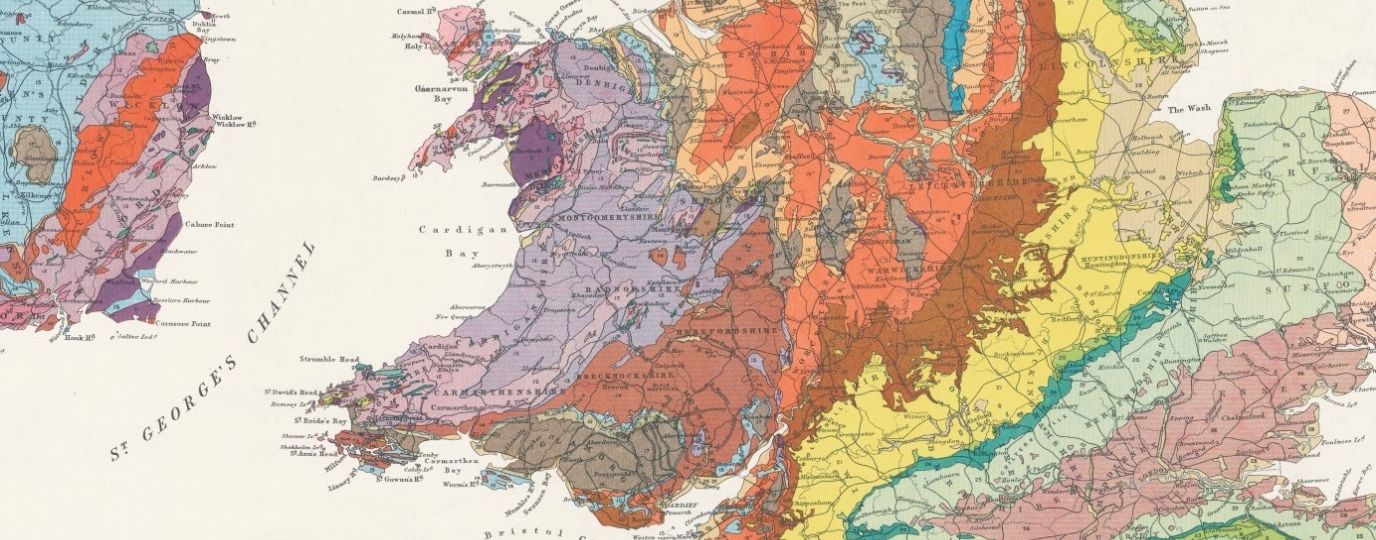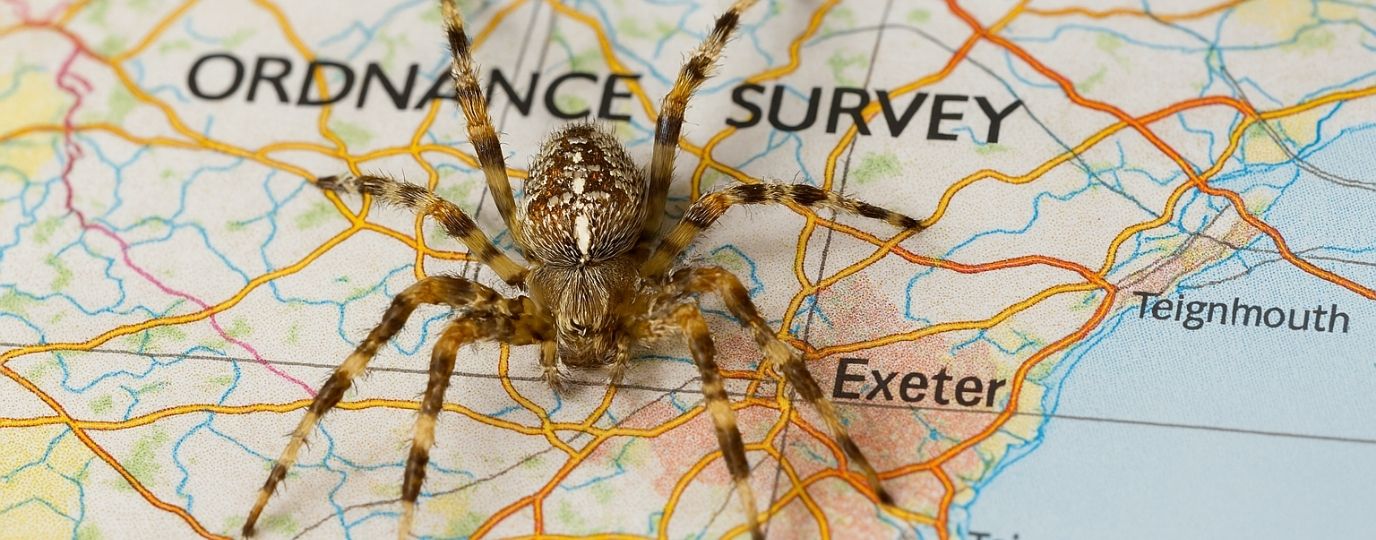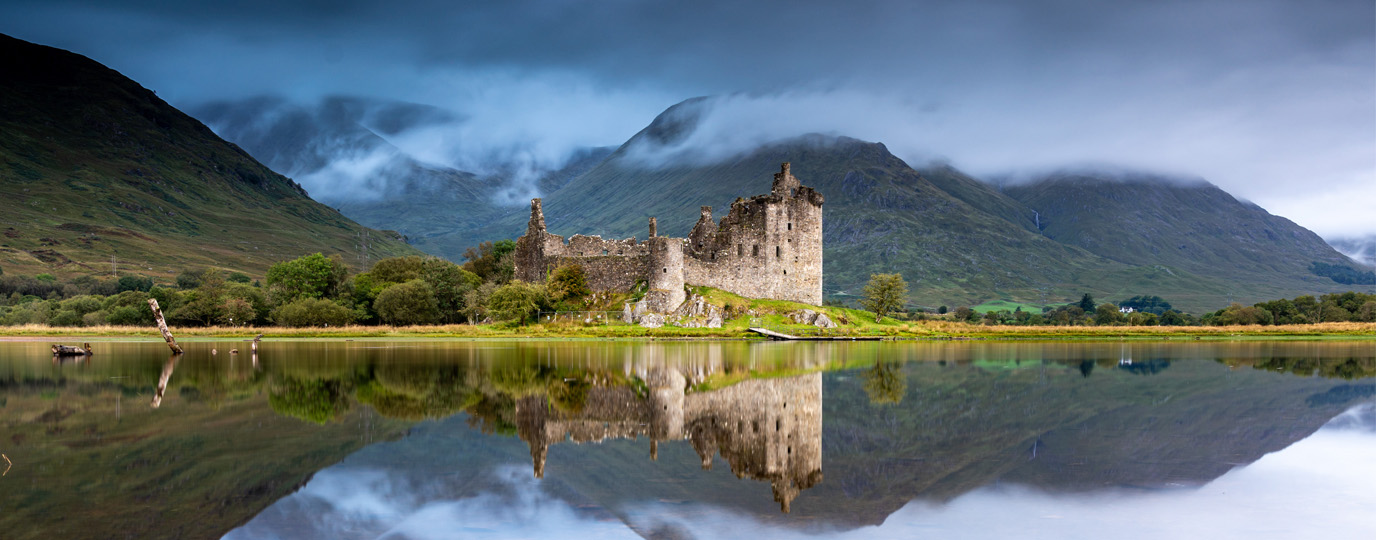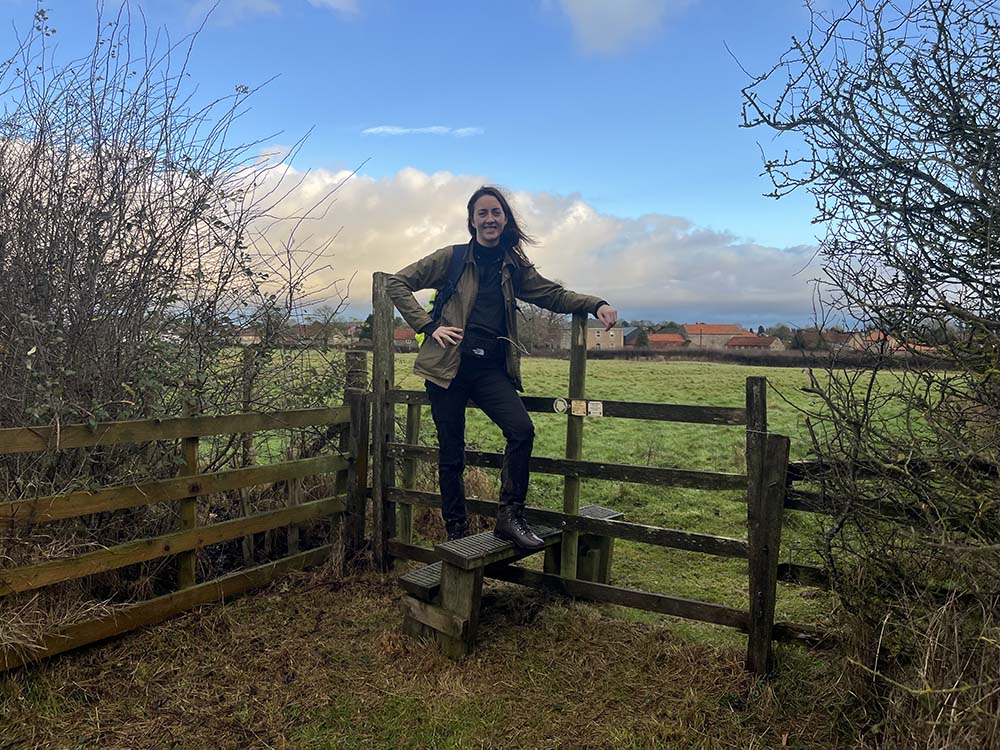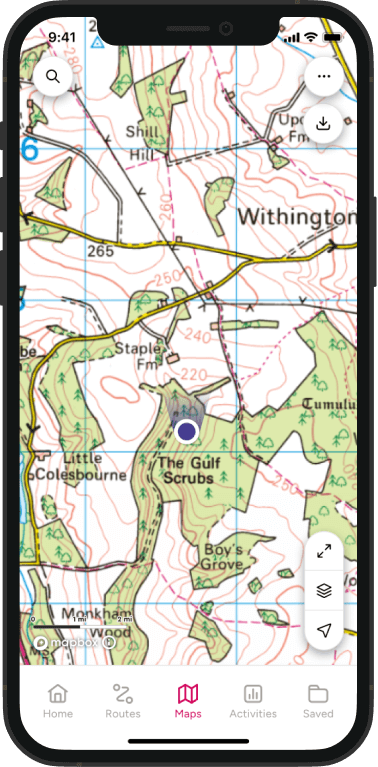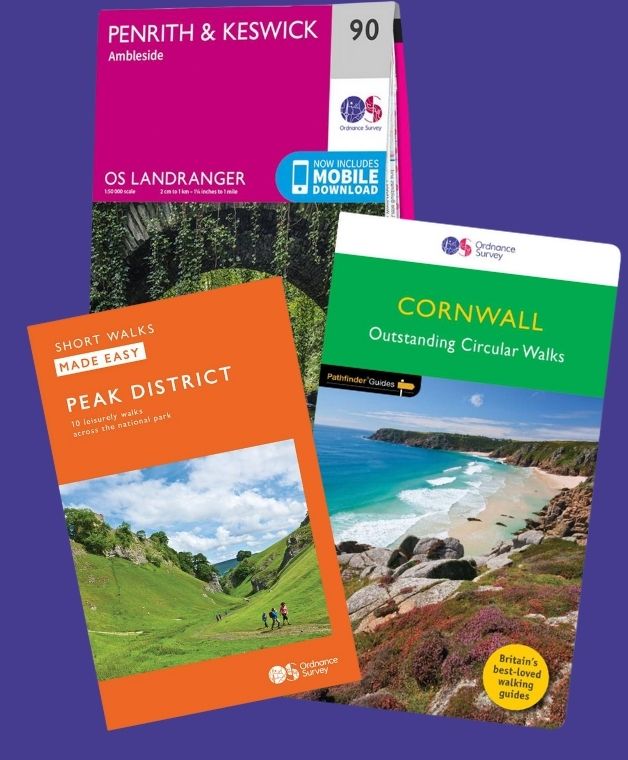What Lies Beneath: Discover the Geology of the British Islands with Our Collectors Edition OS Map
There’s something truly special about standing on a windswept hill, crossing ancient moorland, or walking beside a rugged coastline and pausing to wonder… what’s really beneath your feet? Not just the soil or the grass but the deep, layered story of the Earth itself.
It might sound a bit dramatic, but honestly, that’s because it is! I get such a thrill when I stumble across exposed rock and can actually see the layers, like nature’s own time capsule. I’m no geologist, just a curious explorer, and I hope you are too. Wherever you live Geology has shaped the landscape around you.
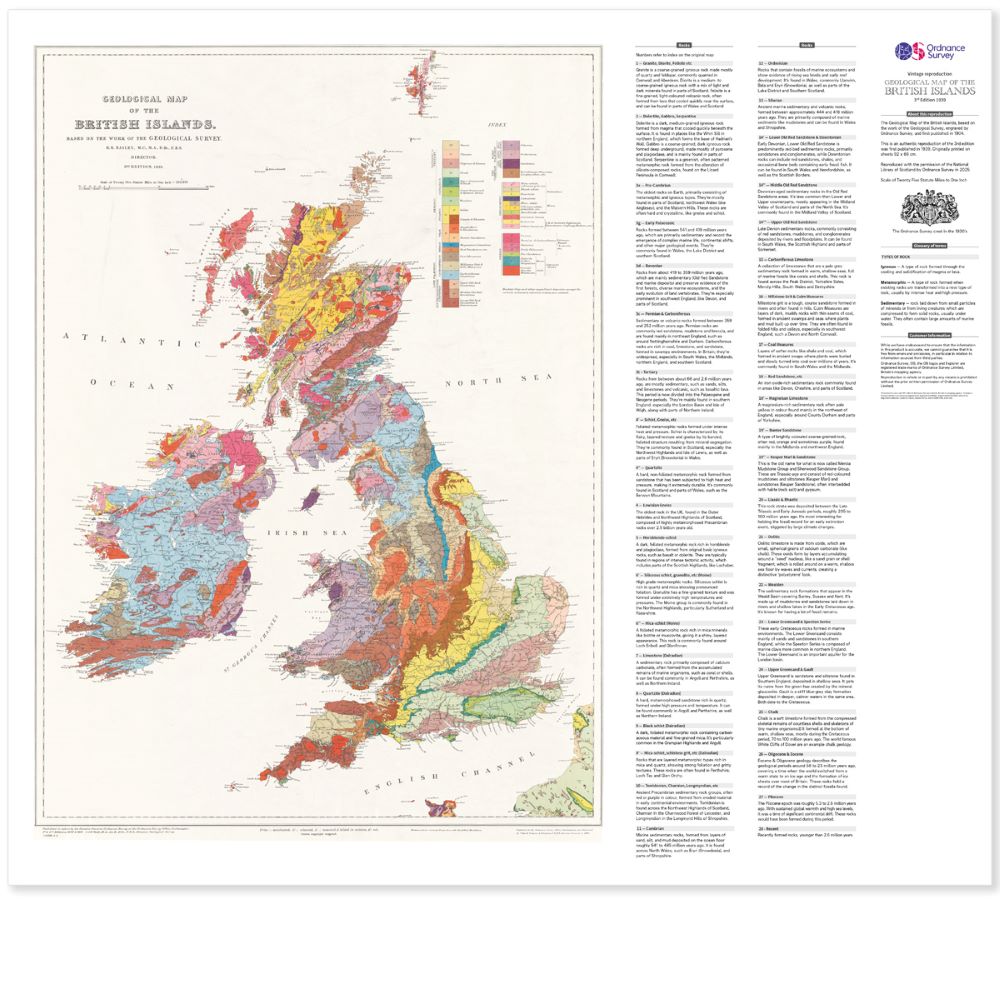
The contours of the land, the type of vegetation, the presence of rivers, caves, cliffs, and even the colour of the soil. Geology determines whether you’re walking on soft sandstone, slippery shale, or rugged granite. It influences the views, the wildlife, and even the history of human settlement.
I’m so excited about the new Collector’s Edition OS Geological Map. It’s a beautiful way to uncover the secrets beneath Britain’s surface and I think you’re going to love it. I also hope you enjoy reading this post and learning a little more about the types of rocks we have in Britain and where you might find them.
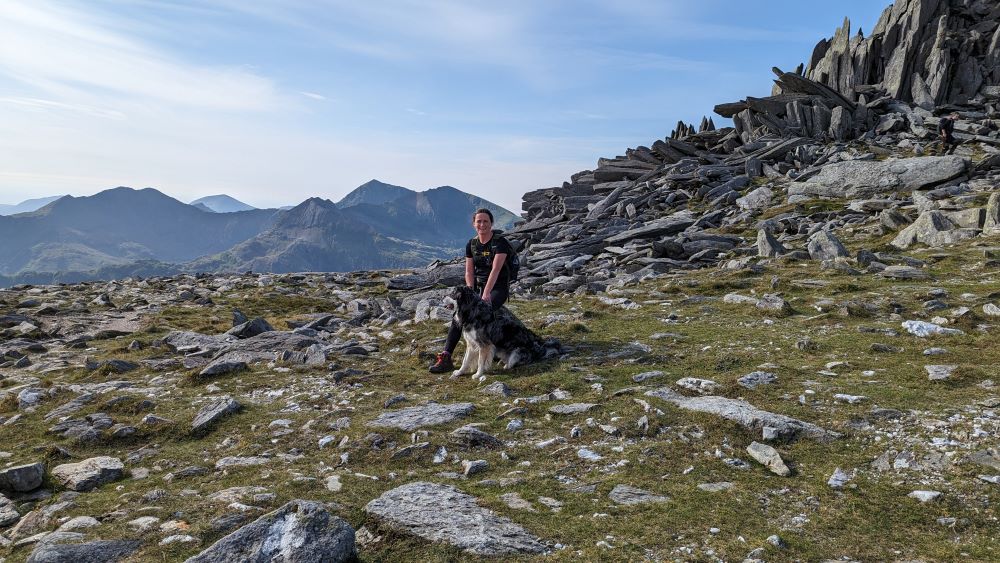
Britain’s geology is incredibly varied, and I think that’s part of what makes our landscapes so compelling. Those dramatic cliffs, rolling valleys, and craggy peaks we love to explore? They’re shaped by millions of years of geological history and often, it’s the differences in rock formations that draw us in and make each place feel unique.
OS Maps vintage Geological Map of Britain is here to help you uncover the secrets of the landscape you love in a most beautiful way. Whether you’re a curious hiker like me, a map collector, or someone who just loves learning more about the natural world, this colourful vintage map is your gateway to understanding how Britain was formed and why it looks the way it does today. An ideal gift for any Geology students in the family too! Each colour represents a different type of rock.
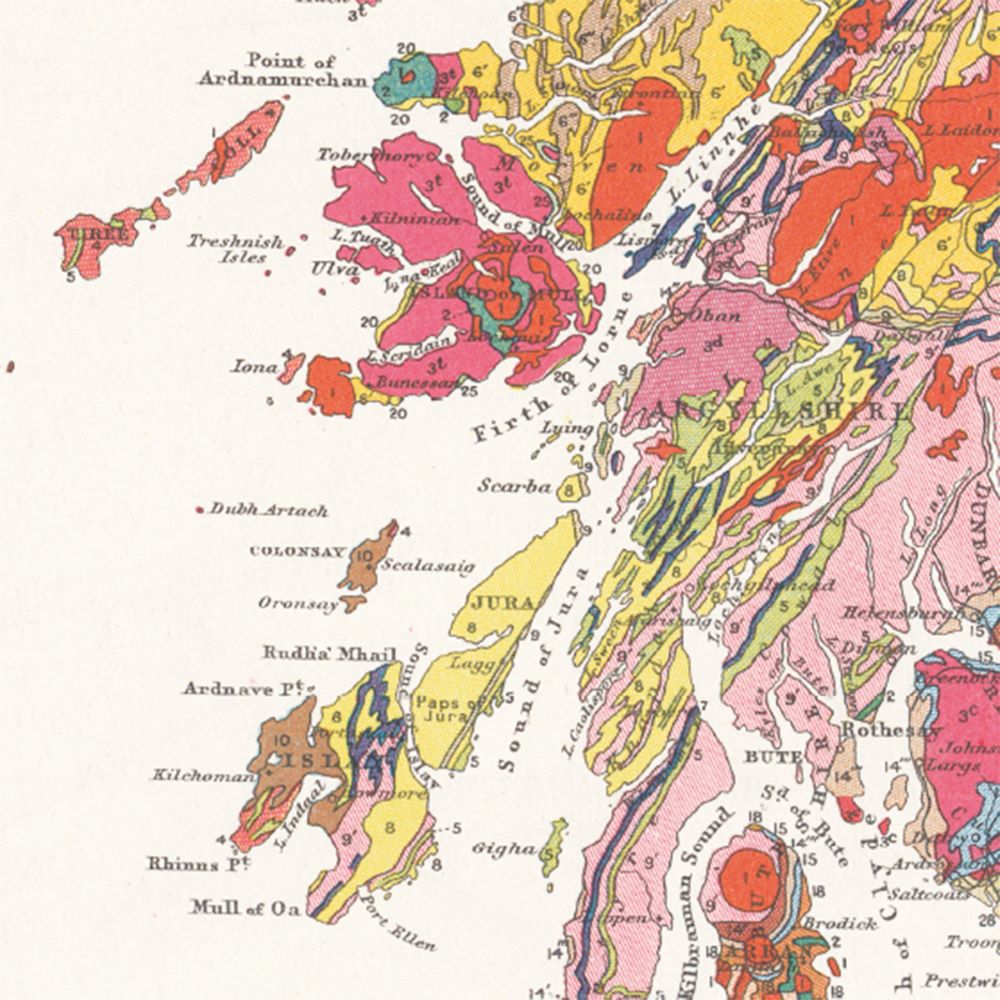
A Walk Through Time: Britain’s Geological History
From the fiery birth of the planet to the rise of dinosaurs and the formation of modern landscapes these are the geological time periods that shaped Britain.
Pre-Cambrian
The earliest part of Earth’s history before complex life appeared, covering 4.6 billion years ago up to 541 million years ago.
Early Palaeozoic
The first part of the Palaeozoic era, stretching between roughly between 541 and 419 million years ago. The first sea creatures began to appear.
Late Palaeozoic
The second half of the Palaeozoic era, lasting from about 419 to 252 million years ago. Forests started to spread and the first reptiles appeared.
Old Red Sandstone & Devonian – The period about 419 to 359 million years ago. Fish diversified dramatically and land-dwelling vertebrates began to appear.
Carboniferous – The period lasing from around 359 to 299 million years ago. Earth was covered in swamp forests, while giant insects and early reptiles emerged.
Permian – The period of about 299 to 252 million years ago, when the supercontinent, Pangaea, was formed and the largest mass extinction in history wiped out most marine and land species.
Mesozoic
The period from about 252 to 66 million years ago. Dinosaurs emerged, along with the first birds and flowering plants.
Trias – The period of about 252 to 201 million years ago, when dinosaurs first appeared and Earth’s continents started to drift apart
Jurassic – The period of 201 to 145 million years ago, when dinosaurs became dominant and the first birds appeared.
Cretaceous – The period from about 145 to 66 million years ago. Dinosaurs reached their peak before an asteroid impact caused their extinction.
Cainozoic or Tertiary
The current era of Earth, starting about 66 million years ago and continuing to today.
The Three Main Rock Types in Britain
Igneous Rocks
Formed from cooled magma or lava, these rocks are the bones of ancient volcanoes. Think of the granite tors of Dartmoor or the Whin Sill in Northumberland — dramatic, rugged, and full of character.
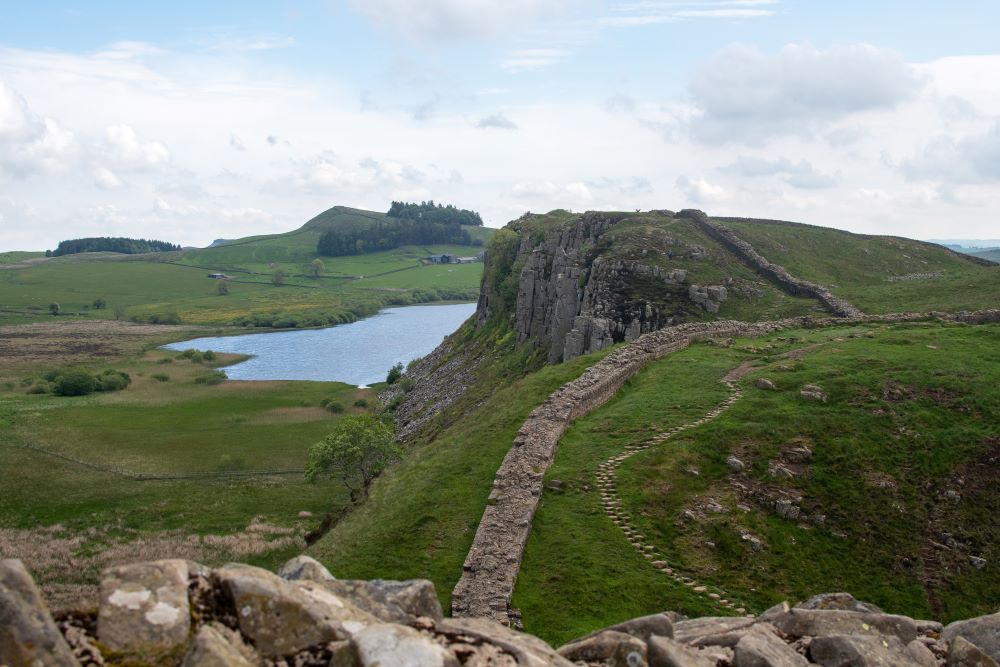
Metamorphic Rocks
Transformed by heat and pressure, these rocks tell stories of tectonic upheaval. You’ll find them in the Scottish Highlands, Snowdonia, Cornwall and parts of Northern Ireland — often tough, folded, and full of texture.
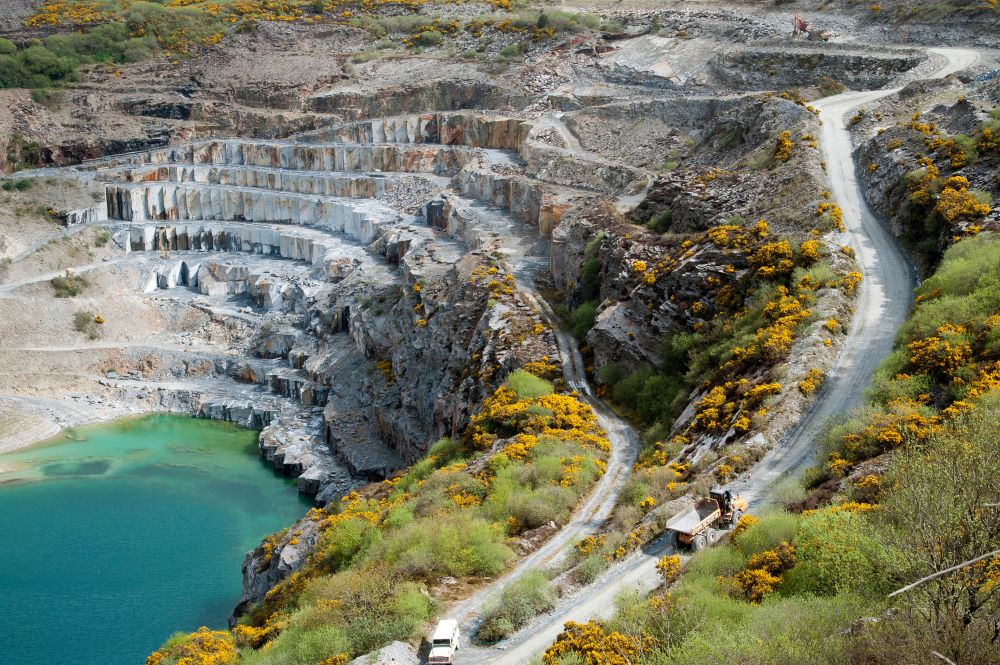
Sedimentary Rocks
Laid down in layers, often under ancient seas, these rocks are made from compressed particles or the remains of marine life. They often contain fossils and form some of Britain’s most iconic walking landscapes — like the limestone pavements of the Yorkshire Dales or the red sandstone cliffs of Devon.
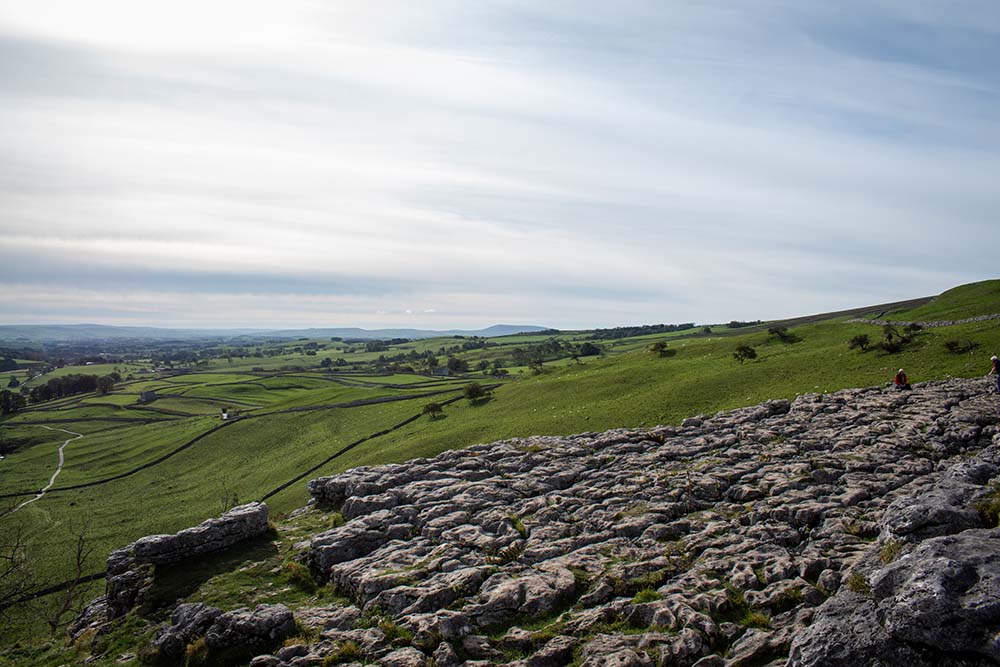
If you’re interested in exploring all kinds of different rocks around the British Isles, we recommend you take a look at the Geological Societies 100 Great Geosites.
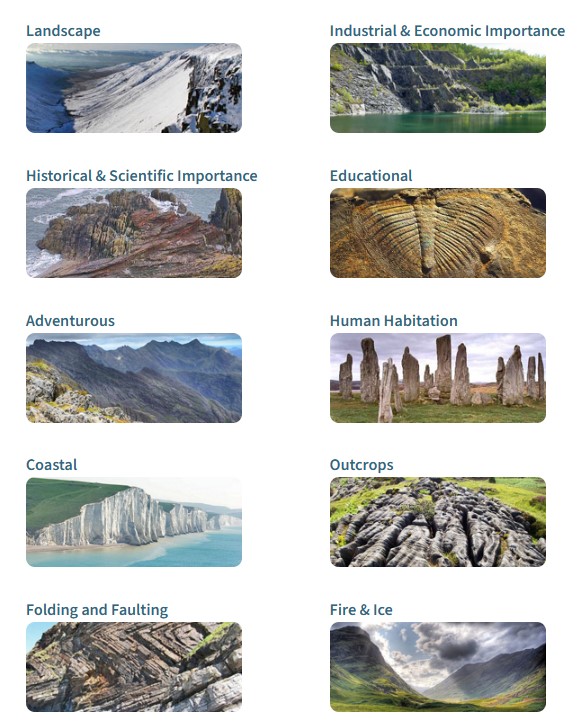
A List of Types of Rock in Britain
Here are the fascinating rock types you can find in Britain.
Granite – Granite is a coarse-grained igneous rock made mostly of quartz and feldspar, commonly quarried in Cornwall and Aberdeen.
Diorite – Diorite is a medium- to coarse-grained igneous rock with a mix of light and dark minerals found in parts of Scotland.
Felisite – Felisite is a fine-grained, light-coloured volcanic rock, often formed from lava that cooled quickly near the surface, and can be found in parts of Wales and Scotland.
Dolerite – Dolerite is a dark, medium-grained igneous rock formed from magma that cooled quickly beneath the surface. It is found in places like the Whin Sill in northern England, which forms the base of Hadrian’s Wall.
Gabbro – Gabbro is a coarse-grained, dark igneous rock formed deep underground, made mostly of pyroxene and plagioclase, and is mainly found in parts of Scotland.
Serpentine – Serpentine is a greenish, often patterned metamorphic rock formed from the alteration of silicate-composed rocks, found on the Lizard Peninsula in Cornwall.
Pre-Cambrian – The oldest rocks on Earth, primarily consisting of metamorphic and igneous types. They’re mostly found in parts of Scotland, northwest Wales (like Anglesey), and the Malvern Hills. These rocks are often hard and crystalline, like gneiss and schist.
Early Palaeozoic – Rocks formed between 541 and 419 million years ago, which are primarily sedimentary and record the emergence of complex marine life, continental shifts, and other major geological events. They’re commonly found in Wales, the Lake District and southern Scotland.
Devonian – Rocks from about 419 to 359 million years ago, which are mainly sedimentary (Old Red Sandstone and marine deposits) and preserve evidence of the first forests, diverse marine ecosystems, and the early evolution of land vertebrates. They’re especially prominent in southwest England, like Devon, and parts of Scotland.
Permian & Carboniferous – Sedimentary or volcanic rocks formed between 359 and 252 million years ago. Permian rocks are commonly red sandstone, mudstone and breccia, and are found mainly in northeast England, such as around Nottinghamshire and Durham. Carboniferous rocks are rich in coal, limestone, and sandstone, formed in swampy environments. In Britain, they’re widespread, especially in South Wales, the Midlands, northern England, and southern Scotland.
Tertiary – Rocks from between about 66 and 2.6 million years ago, are mostly sedimentary, such as sands, silts, and limestones and volcanic, such as basaltic lava. This period is now divided into the Palaeogene and Neogene periods. They’re mainly found in southern England, especially the London Basin and Isle of Wigh, along with parts of Northern Ireland.
Schist & Gneiss – Foliated metamorphic rocks formed under intense heat and pressure. Schist is characterized by its flaky, layered texture and gneiss by its banded, foliated structure resulting from mineral segregation. They’re commonly found in Scotland, especially the Northwest Highlands and Isle of Lewis, as well as parts of Snowdonia in Wales.
Quartzite – A hard, non-foliated metamorphic rock formed from sandstone that has been subjected to high heat and pressure, making it extremely durable. It’s commonly found in Scotland and parts of Wales, such as the Berwyn Mountains.
Lewisian Gneiss – The oldest rock in the UK, found in the Outer Hebrides and Northwest Highlands of Scotland, composed of highly metamorphosed Precambrian rocks over 2.5 billion years old.
Hornblende-schist – A dark, foliated metamorphic rock rich in hornblende and plagioclase, formed from original basic igneous rocks, such as basalt or dolerite. They are typically found in regions of intense tectonic activity, which includes parts of the Scottish Highlands, like Lochaber.
Siliceous schist, granulite (Moine) – High grade metamorphic rocks. Siliceous schist is rich in quartz and mica showing pronounced foliation. Granulite has a fine-grained texture and was formed under extremely high temperatures and pressures. The Moine group is commonly found in the Northwest Highlands, particularly Sutehrland and Ross-shire.
Mica-schist (Moine) – A foliated metamorphic rock rich in mica minerals like biotite or muscovite, giving it a shiny, layered appearance. This rock is commonly found around Loch Eriboll and Glenfinnan.
Limestone (Dalradian) – A sedimentary rock primarily composed of calcium carbonate, often formed from the accumulated remains of marine organisms, such as coral or shells. It can be found commonly in Argyll and Perthshire, as well as Northern Ireland.
Quartzite (Dalradian) – A hard, metamorphosed sandstone rich in quartz, formed under high pressure and temperature. It can be found commonly in Argyll and Perthshire, as well as Northern Ireland.
Black schist (Dalradian) – A dark, foliated metamorphic rock containing carbonaceous material and fine-grained mica. It’s particularly common in the Grampian Highlands and Argyll.
Mica-schist, schistose grit, etc (Dalradian) – Rocks that are layered metamorphic types rich in mica and quartz, showing strong foliation and gritty textures. These rocks are often found in Perthshire, Loch Tay and Glen Orchy.
Torridonian, Charnian, Longmyndian – Ancient Precambrian sedimentary rock groups, often red or purple in colour, formed from eroded material in early continental environments. Torridonian is found across the Northwest Highlands of Scotland, Charnian In the Charnwood Forest of Leicester, and Longmyndian in the Longmynd Hills of Shropshire.
Cambrian – Marine sedimentary rocks, formed from layers of sand, silt, and mud deposited on the ocean floor roughly 541 to 485 million years ago. It is found across North Wales, such as Snowdownia, and parts of Shropshire.
Ordovician – Rocks that contain fossils of marine ecosystems and show evidence of rising sea levels and early reef development. It’s found in Wales, commonly Llanvirn, Bala and Snowdonia, as well as parts of the Lake District and Southern Scotland.
Silurian – Ancient marine sedimentary and volcanic rocks, formed between approximately 444 and 416 million years ago. They are primarily composed of marine sediments like mudstones and can be found in Wales and Shropshire.
Lower Old Red Sandstone & Downtonian – Early Devonian, Lower Old Red Sandstone is predominantly red-bed sedimentary rocks, primarily sandstones and conglomerates, while Downtonian rocks can include red sandstones, shales, and occasional bone beds containing early fossil fish. It can be found in South Wales and Herefordshire, as well as the Scottish Borders.
Middle Old Red Sandstone – Devonian-aged sedimentary rocks in the Old Red Sandstone areas. It’s less common than Lower and Upper counterparts, mostly appearing in the Midland Valley of Scotland and parts of the North Sea. It’s commonly found in the Midland Valley of Scotland.
Upper Old Red Sandstone – Late Devion sedimentary rocks, commonly consisting of red sandstones, mudstones, and conglomerates deposited by rivers and floodplains. It can be found in South Wales, the Scottish Highland and parts of Somerset.
Carboniferous Limestone – A collection of limestones that are a pale grey sedimentary rock formed in warm, shallow seas, full of marine fossils like corals and shells. This rock is found across the Peak District, Yorkshire Sales, Mendip Hills, South Wales and Derbyshire.
Millstone Grit & Culm Measures – Milestone grit is a tough, course sandstone formed in rivers and often found in hills. Culm Measures are layers of dark, muddy rocks with thin seams of coal, formed in ancient swamps and seas where plants and mud built up over time. They are often found in folded hills and valleys, especially in southwest England, such a Devon and North Cornwall.
Coal Measures – Layers of softer rocks like shale and coal, which formed in ancient swaps where plants were buried and slowly turned into coal over millions of years. It’s commonly found in South Wales and the Midlands.
Red Sandstone – An iron oxide-rich sedimentary rock commonly found in areas like Devon, Cheshire, and parts of Scotland.
Magneisan Limestone – A magnesium-rich sedimentary rock often pale yellow in colour found mainly in the northeast of England, especially around County Durham and parts of Yorkshire.
Bunter Sandstone – A type of brightly coloured coarse-grained rock, often red, orange and sometimes purple, found mainly in the Midlands and northwest England.
Keuper Marl & Sandstone – This is the old name for what is now called Mercia Mudstone Group and Sherwood Sandstone Group. These are Triassic-age and consist of red-coloured mudstones and siltstones (Keuper Marl) and sandstones (Keuper Sandstone), often interbedded with halite (rock salt) and gypsum.
Liassic & Rhaetic – This rock strata was deposited between the Late Triassic and Early Jurassic periods, roughly 205 to 180 million years ago. It’s most interesting for holding the fossil record for an early extinction event, triggered by large climate changes.
Oolitic – Oolitic limestone is made from ooids, which are small, spherical grains of calcium carbonate (like chalk). These ooids form by layers accumulating around a “seed” nucleus, like a sand grain or shell fragment, which is rolled around on a warm, shallow sea floor by waves and currents, creating a distinctive ‘polystyrene’ look.
Wealden – The sedimentary rock formations that appear in the Weald Basin covering Surrey, Sussex and Kent. It’s made up of mudstones and sandstones laid down in rivers and shallow lakes in the Early Cretaceous age. It’s known for having a lot of fossil remains.
Lower Greensand & Speeton Series -These early Cretaceous rocks formed in marine environments. The Lower Greensand consists mainly of sands and sandstones in southern England, while the Speeton Series is composed of marine clays more common in northern England. The Lower Greensand is an important aquifer for the London basin.
Upper Greensand & Gault – Upper Greensand is sandstone and siltstone found in Southern England, deposited in shallow seas. It gets its name from the green hue created by the mineral glauconite. Gault is a stiff blue-grey clay formation deposited in deeper, calmer waters in the same area. Both date to the Cretaceous.
Chalk – Chalk is a soft limestone formed from the compressed skeletal remains of countless shells and skeletons of tiny marine organisms. It formed at the bottom of warm, shallow seas, mostly during the Cretaceous period, 70 to 100 million years ago. The world famous White Cliffs of Dover are an example chalk geology.
Oligocene & Eocene – Eocene & Oligocene geology describes the geological periods around 56 to 23 million years ago, covering a time when the world switched from a warm state to an ice age and the formation of ice sheets over most of Britain. These rocks hold a record of the change in the distinct fossils found.
Pliocene – The Pliocene epoch was roughly 5.3 to 2.6 million years ago. With sustained global warmth and high sea levels, it was a time of significant continental drift. These rocks would have been formed during this period.
Ready to Walk Through Time?
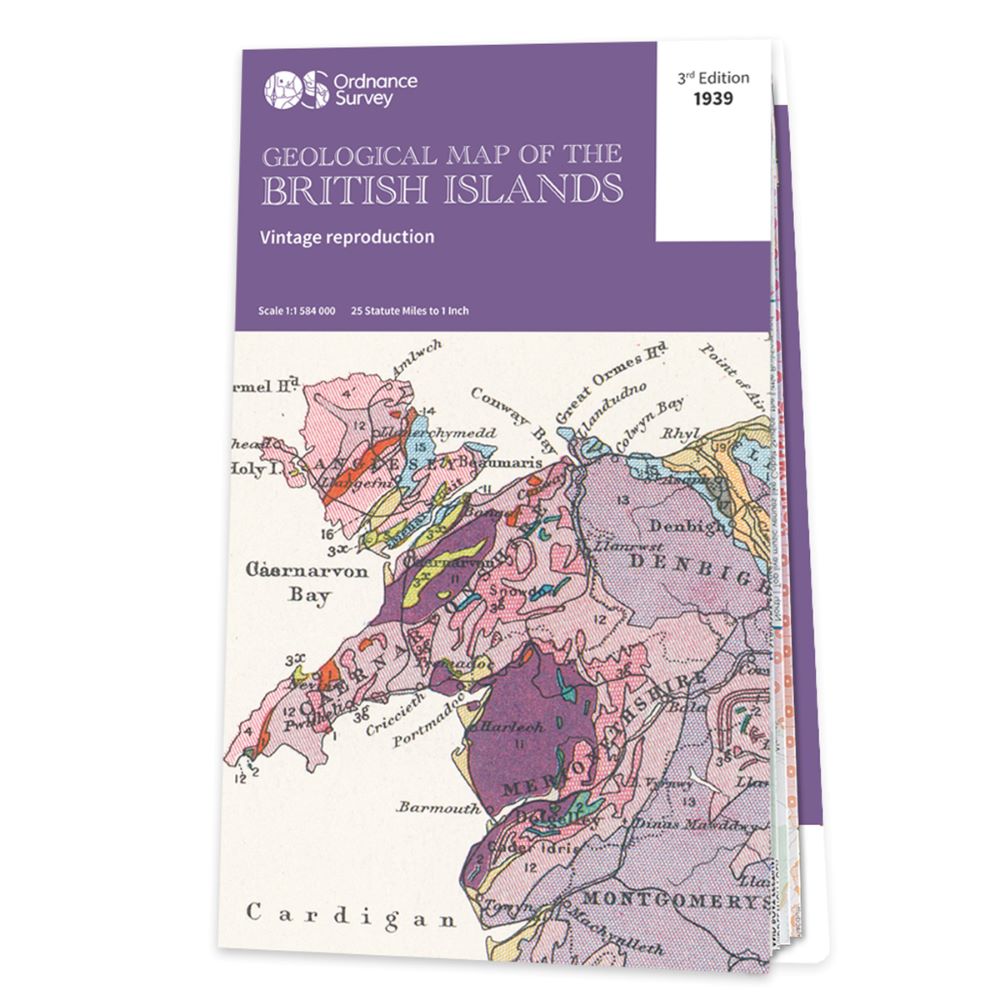
The Geological Map of Britain is the perfect companion for curious walkers, geology fans, and anyone who wants to deepen their connection to the land. The perfect gift for map lovers, hikers and people who love to explore.
Get your copy now and start exploring the ancient stories beneath your feet.
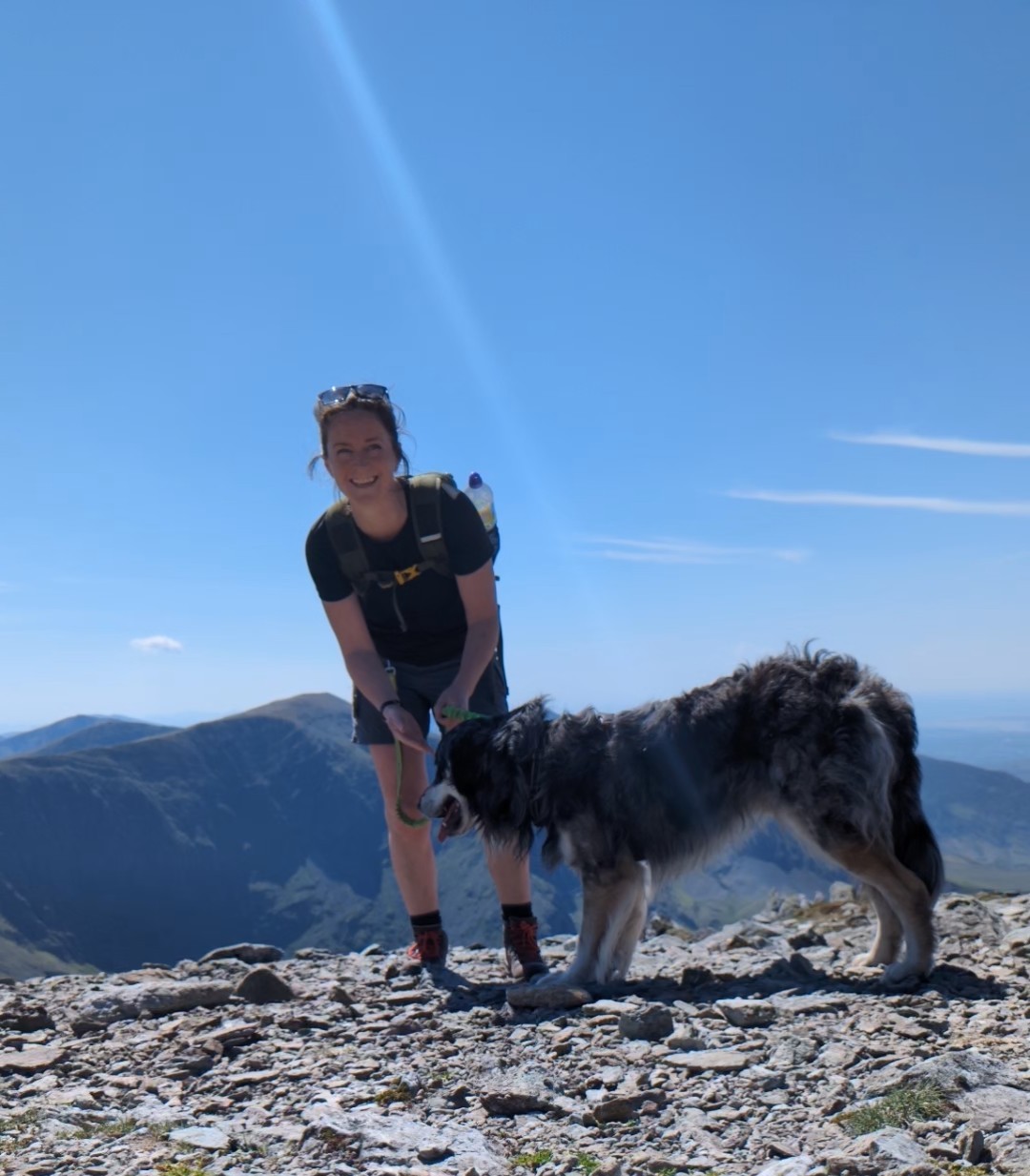
By Hilary Pullen
Meet Hilary, Editor of Get Outside – the Ordnance Survey Blog. Hilary is based in North Wales and loves hiking with her dogs in the mountains of Eryri and Bryniau Clwyd, you can find her on Instagram @nearlyuphill and read her guides to walking in North Wales on her blog. Drop her an email hilary.pullen@os.uk if you are interested in posting an article on Get Outside.
